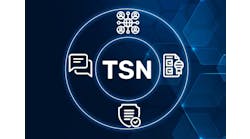The impact of time-sensitive networking on EtherNet/IP
Time-sensitive networking (TSN) has its own gravitational pull, said Steve Zuponcic, technology manager at Rockwell Automation. “We think we’re in charge of our own destiny, but TSN started as an audio-video bridging outside of our industry,” he explained. “IEEE is starting to make changes to standard Ethernet, and some forces are starting to pull. We have to start paying attention and responding to that. We need to be aware and take appropriate actions.”
Zuponcic’s warning was one of many discussions regarding TSN, including enhancements to IEEE 802.1 and the Internet Engineering Task Force (IETF) DetNet for wide-area deterministic networks, at the 2017 ODVA Industry Conference in Palm Harbor, Florida. “IEEE is driving at Layer 2, and IETF is driving at Layer 3,” explained Zuponcic. “IEEE 802.1 is a lot of standards—some published, some in final ballot, some in progress and some under consideration. It’s safe to say that among the different technologies and standards, a significant amount of work is being done with scheduled Ethernet, including new prioritization and tight predictable control of multiple traffic streams.”
ALSO READ: What is time-sensitive networking?
Scheduled traffic is given the highest priority above all else. Today’s implementation of CIP traffic would fall into a rate-constrained or best-effort category. On a lightly loaded system, rate-constrained traffic can coexist. When you look at a frame of time and the duty cycle becomes large enough, the CIP traffic, the rate-constrained traffic, has less and less. And, if planned data streams can’t be accommodated, the network can be modified by adding topology paths, increasing speed or altering requested packet intervals (RPIs). “A core precept of the TSN value proposition is that all network communications are managed so that there is a guarantee for performance and for data delivery,” explained Zuponcic. “If all streams are defined, payloads are known and maximum data delivery latencies are provided, system network calculations can determine if successful operation of the network is achievable. All devices need to participate in traffic planning by publishing to or notifying a centralized network configuration (CNC) engine of their traffic requirements for the connections involved.”
The CNC function has the role of configuring the infrastructure, explained Zuponcic. “It communicates with the centralized user configuration (CUC) tools to receive stream information,” he said. “In an industrial system, the CUC is most likely part of the PLC programming software for off-line configuration or part of the PLC during runtime. When we configure a PLC, we set up the RPIs. The payloads are already given; that information is already there.”
How do we get things to coexist? “System-level configuration allows for control of both the network and the application,” explained Zuponcic. “The CNC must solve and configure for successful operation of the application given all existing constraints. Policy-based prioritization is counterbalance against data delivery mechanisms. The CNC policy engine configures the network based on policies, as well as capabilities and constraints of the infrastructure and the devices it’s configuring.”
The CNC is responsible for blending scheduled traffic and rate-constrained traffic or both to provide proper management of the system.
“A logical place to put the CNC is in the PLC,” offered Rudy Klecka, technical lead at Cisco. “It’s just a piece of software. We could run it in an appliance. We could put it in a switch. But, most likely, it will be put into a PLC. Define the inputs and the outputs of the CNC, and then let the market figure out the best algorithms. The CNC knows the topology.”
Modern industrial networks combine the disciplines of both information technology (IT) and operations technology (OT) to meet the requirements of industrial applications. “The industrial control networking legacy is long established,” Zuponcic reminded. “We haven’t been motivated toward convergence historically. It demands an holistic approach and a system view as we go toward TSN. Lack of participation results in lack of service. Your traffic will get run over.”
Mike Bacidore is the editor in chief for Control Design magazine. He is an award-winning columnist, earning a Gold Regional Award and a Silver National Award from the American Society of Business Publication Editors. Email him at [email protected].






